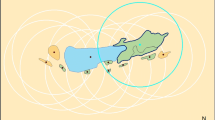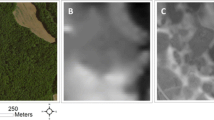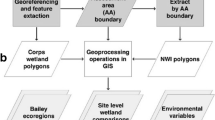Abstract
Wetland contiguity and edge were determined with a geographic information system (GIS) for five coastal counties in North Carolina. USA. The digital database was created from wetlands digitized from U.S. Fish and Wildlife Service National Wetlands Inventory maps. The GIS analysis was based on three classes of information: 1) all wetlands as one class; 2) wetlands separated by dominant vegetative community type (e.g., forest, shrub, or marsh); and 3) forest and shrub wetlands further separated by dominant vegetation (e.g., evergreen, deciduous, or mixed). The contiguity analysis supports the perception that the lower coastal plain counties are dominated by large contiguous wetlands When wetlands were clumped into one class, the number of wetlands >1,000 ha ranged from 2 to 7 and the area accounted for 77 to 96% of the total wetland area. Several of those sites were > 100,000 ha in size. When wetlands were separated into more specific classes, the number of sites < 10 ha ranged from 416 to 3,370, but the wetland area in this size class was < 5% of the total wetland area. The average size of evergreen forest and shrub wetlands was typically much greater than deciduous forest and shrub wetlands a reflection of the configuration of large, block pocosin wetlands. Percent edge was also typically lower for the evergreen forest and shrub wetlands than for deciduous forest and shrub wetlands. The counties with the highest, number of wetland sites in transition to other uses have the most land owned by private timber companies. Contiguity analysis of wetlands with GIS provides landscape-scale information for natural resource management issues such as preserve design, habitat fragmentation, rare species management, and species migration opportunities.
Similar content being viewed by others
Literature Cited
Brinson, M. M. 1991. Landscape properties of pocosins and associated wetlands. Wetlands 11:441–465.
Cashin, G. E., J. R. Dorney, and C. J. Richardson. 1992. Wetland alteration trends on the North Carolina Coastal Plain. Wetlands 12:63–71.
Congdon, J. D. and R. E. Gatten. 1989. Movement and energetics of nestingChrysemys picta. Herpetologica 45:94–100.
Cowardin, L. M., V. Carter, F. Golet, and E. T. LaRoe. 1979. Classification of wetlands and deepwater habitats of the United States. US. Department of Interior, Fish and Wildlife Service, Washington, DC, USA. FWS/OBS-79/31.
Cross, H. C., P. D. Wettin, and F. M. Keenan. 1991. Corridors for wetland conservation and management? Room for conjecture. p. 159–165.In D. A. Saunders and R. J. Hobbs (eds). Nature Conservation 2: The Role of Corridors. Surrey Beatty & Sons, Sidney, Australia.
DeMers, M. N. 1997. Fundamentals of Geographic Information Systems. John Wiley and Sons. New York, NY, USA.
Dodd, C. K., Jr. 1996. Use of terrestrial habitats by amphibians in the sandhill uplands of north-central Florida. Alytes 14:42–52.
Fahrig, L. and H. G. Merriam. 1985. Habitat patch connectivity and population survival. Ecology 66:1762–1768.
Freemark, K. E. and H. G. Merriam. 1986. Importance of area and habitat heterogeneity to bird assemblages in temperate forest fragments. Biological Conservation 36:115–141.
Hairston, N. G., Sr. 1987. Community Ecology and Salamander Guilds. Cambridge University Press, Cambridge, UK.
Hall, B. (Project Director). 1986. Who owns North Carolina? Institute for Southern Studies, Durham, NC, USA.
Hefner, J. M. and J. D. Brown. 1985. Wetland trends in the southcastern United States. Wetlands 4:1–11.
Liu, J., J. B. Dunning, Jr., and H. R. Pulliam. 1995. Potential effects of a forest management plan on Bachman’s sparrows (Aimophila aestivalis): linking a spatially explicit model with GIS. Conservation Biology 9:62–75.
Madison, D. M. 1997. The emigration of radio-implanted spotted salamanders,Ambystoma maculatum. Journal Herpetology 31:542–551.
Moorhead, K. K. 1992. Wetland resources of coastal North Carolina. Wetlands. 12:184–191.
North Carolina. 1989. State of the Environment Report. North Carolina Department of Natural Resources and Community Development, Raleigh, NC, USA.
Noss, R. F. 1983. A regional landscape approach to maintain diversity. Bioscience 33:700–706.
Pearson, S. M. 1994. Landscape-level processes and wetland conservation in the southern Appalachian mountains. Water. Soil, and Air Pollution 77:321–332.
Richardson, C. J., R. Evans, and D. Carr. 1981. Pocosins: An ecosystem in transition. p.3–19.In C. J. Richarson (ed.) Pocosin Wetlands. Hutchinson Ross Publishing Company, Strondsburg, PA. USA.
Saunders, D. A., R. J. Hobbs, and C. R. Margules. 1991. Biological consequences of ecosystem fragmentation: a review. Conservation Biology 5:18–32.
Semlitsch, R. D. 1981. Terrestrial activity and summer home range of the mole salamander (Ambystoma talpoideum). Canadian Journal of Zoology 59:315–322.
Sharitz, R. R. and J. W. Gibbons, 1982. The ecology of southeastern shrub bogs (pocosins) and Carolina bays: a community profile. US Fish and Wildlife Service, Office of Biological Services, Washington, DC, USA FWS/OBS-82/04.
Stockton, M. B. and C. J. Richardson. 1987. Wetland development trends in coastal North Carolina, USA, from 1970 to 1984. Environmental Management 11:649–657.
Turner, M. G. 1989. Landscape ecology: the effect of pattern on process. Annual Review of Ecology and Systematics 20:171–197.
Wilbur, H. M. 1981 Pocosin fauna. p.62–68.In C. J. Richardson (ed.). Pocosin Wetlands. Hutchinson Ross Publishing Company, Stroudsburg, PA, USA.
Wilson, K. A. 1962. North Carolina Wetlands. Their Distribution and Management. North Carolina Wildlife Resources Commission. Raleigh, NC, USA.
Author information
Authors and Affiliations
Rights and permissions
About this article
Cite this article
Moorhead, K.K. Contiguity and edge characteristics of wetlands in five coastal counties of north Carolina, USA. Wetlands 19, 276–282 (1999). https://doi.org/10.1007/BF03161757
Received:
Revised:
Accepted:
Issue Date:
DOI: https://doi.org/10.1007/BF03161757




